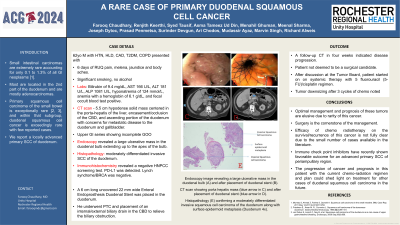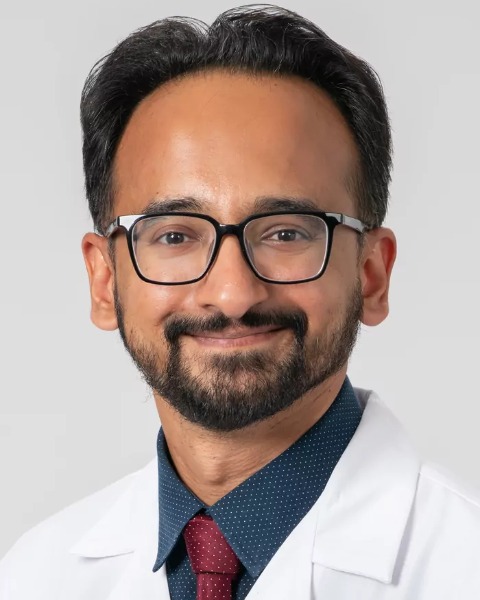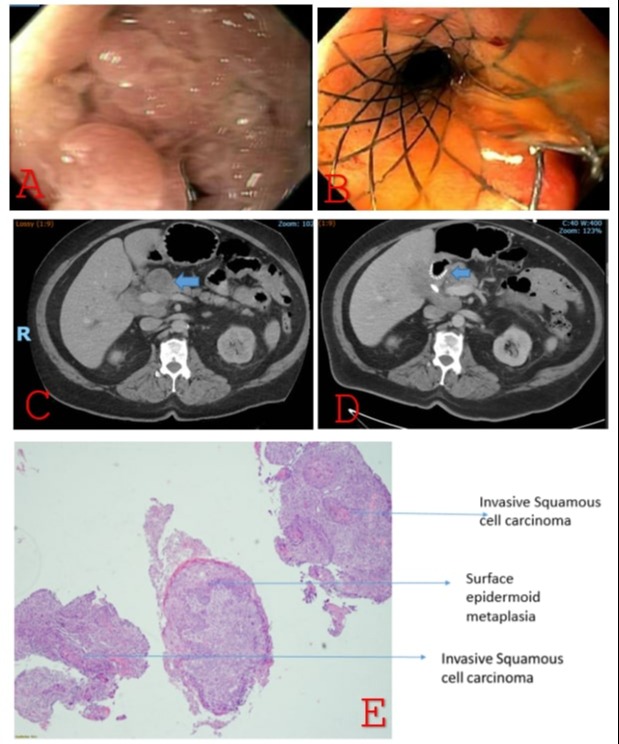Sunday Poster Session
Category: Small Intestine
P1576 - A Rare Case of Primary Duodenal Squamous Cell Cancer
Sunday, October 27, 2024
3:30 PM - 7:00 PM ET
Location: Exhibit Hall E

Has Audio

Farooq Chaudhary, MD, MRCP
Rochester Regional Health, Unity Hospital
Webster, NY
Presenting Author(s)
Farooq Chaudhary, MD, MRCP1, Keerthi Mannumbeth Renjith, MD2, Tausif Syed, MD3, Asma Tameez Ud Din, MBBS4, Menahil Ghuman, MBBS5, Meenal Sharma, MD2, Joseph Dytoc, MD2, Prasad Penmetsa, MD2, Surinder Devgun, MD2, Ari Chodos, MD2, Mudassir Ayaz, MD2, Farooq Chaudhary, MD2, Richard Alweis, MD2
1Rochester Regional Health, Unity Hospital, Webster, NY; 2Rochester Regional Health, Unity Hospital, Greece, NY; 3Rochester General Hospital, Greece, NY; 4Guy's and St. Thomas’ NHS Foundation Trust, Webster, NY; 5Rawalpindi Medical University, Ontario, ON, Canada
Introduction: Primary squamous cell carcinoma of the small bowel is exceptionally rare, and even within that subgroup, duodenal squamous cell cancer is exceedingly rare with only a very few cases reported to date.
Case Description/Methods: 62-year-old male with a past medical history significant for HTN, HLD, CAD, T2DM, COPD, opioid dependence and tobacco use disorder (50 pack years) presented to our hospital for evaluation of 6 days history of right upper quadrant abdominal pain and jaundice.
His blood work was notable for elevated total bilirubin of 9.4 mg/dL, AST/ALT 166/181 U/L, ALP 1081 U/L, hyponatremia of 124, anemia 6.1 mg/dL and stool for occult blood positive. CT scan revealed a 5.5 cm hypodense solid mass centered in the porta hepatis of the liver, encasement and occlusion of the CBD and ascending portion of the duodenum with concerns for metastatic disease to the duodenum and gallbladder. Endoscopy revealed a large ulcerative mass in duodenal bulb extending up to the apex of the bulb. Biopsies confirmed it to be moderately differentiated invasive squamous cell carcinoma of the duodenum.
A 6 cm long uncovered 22 mm wide Enteral Endoprosthesis Duodenal Stent was placed under endoscopic and fluoroscopic guidance to relieve partial obstruction. He underwent Percutaneous transhepatic cholangiography and placement of an internal/external biliary drain under sonographic and fluoroscopic guidance in the CBD to relieve the biliary obstruction. Immunohistochemistry revealed a negative HNPCC screening test based on the absence of protein expression for MLH1, MSH2, MSH6, and PMS2, indicating a low risk of having an inherited cancer predisposition syndrome. Programmed death-ligand 1 (PD-L1) expression was low at 2%.
Follow up CT in four weeks indicated wall thickening in the duodenum, direct extension of the tumor into liver, and pancreatic region lymphadenopathy. Surgical oncology did not deem the patient to be a surgical candidate. He received 5-fluorouracil (5-FU)/cisplatin chemotherapy and follow up scans showed reduction in tumor size.
Discussion: Optimal management and prognosis of these tumors remain elusive due to the rarity of this cancer. While surgery is curative for this cancer, most patients are not surgical candidates at the time of diagnosis. Our case adds on to the limited literature already available for this cancer to better understand it.

Disclosures:
Farooq Chaudhary, MD, MRCP1, Keerthi Mannumbeth Renjith, MD2, Tausif Syed, MD3, Asma Tameez Ud Din, MBBS4, Menahil Ghuman, MBBS5, Meenal Sharma, MD2, Joseph Dytoc, MD2, Prasad Penmetsa, MD2, Surinder Devgun, MD2, Ari Chodos, MD2, Mudassir Ayaz, MD2, Farooq Chaudhary, MD2, Richard Alweis, MD2. P1576 - A Rare Case of Primary Duodenal Squamous Cell Cancer, ACG 2024 Annual Scientific Meeting Abstracts. Philadelphia, PA: American College of Gastroenterology.
1Rochester Regional Health, Unity Hospital, Webster, NY; 2Rochester Regional Health, Unity Hospital, Greece, NY; 3Rochester General Hospital, Greece, NY; 4Guy's and St. Thomas’ NHS Foundation Trust, Webster, NY; 5Rawalpindi Medical University, Ontario, ON, Canada
Introduction: Primary squamous cell carcinoma of the small bowel is exceptionally rare, and even within that subgroup, duodenal squamous cell cancer is exceedingly rare with only a very few cases reported to date.
Case Description/Methods: 62-year-old male with a past medical history significant for HTN, HLD, CAD, T2DM, COPD, opioid dependence and tobacco use disorder (50 pack years) presented to our hospital for evaluation of 6 days history of right upper quadrant abdominal pain and jaundice.
His blood work was notable for elevated total bilirubin of 9.4 mg/dL, AST/ALT 166/181 U/L, ALP 1081 U/L, hyponatremia of 124, anemia 6.1 mg/dL and stool for occult blood positive. CT scan revealed a 5.5 cm hypodense solid mass centered in the porta hepatis of the liver, encasement and occlusion of the CBD and ascending portion of the duodenum with concerns for metastatic disease to the duodenum and gallbladder. Endoscopy revealed a large ulcerative mass in duodenal bulb extending up to the apex of the bulb. Biopsies confirmed it to be moderately differentiated invasive squamous cell carcinoma of the duodenum.
A 6 cm long uncovered 22 mm wide Enteral Endoprosthesis Duodenal Stent was placed under endoscopic and fluoroscopic guidance to relieve partial obstruction. He underwent Percutaneous transhepatic cholangiography and placement of an internal/external biliary drain under sonographic and fluoroscopic guidance in the CBD to relieve the biliary obstruction. Immunohistochemistry revealed a negative HNPCC screening test based on the absence of protein expression for MLH1, MSH2, MSH6, and PMS2, indicating a low risk of having an inherited cancer predisposition syndrome. Programmed death-ligand 1 (PD-L1) expression was low at 2%.
Follow up CT in four weeks indicated wall thickening in the duodenum, direct extension of the tumor into liver, and pancreatic region lymphadenopathy. Surgical oncology did not deem the patient to be a surgical candidate. He received 5-fluorouracil (5-FU)/cisplatin chemotherapy and follow up scans showed reduction in tumor size.
Discussion: Optimal management and prognosis of these tumors remain elusive due to the rarity of this cancer. While surgery is curative for this cancer, most patients are not surgical candidates at the time of diagnosis. Our case adds on to the limited literature already available for this cancer to better understand it.

Figure: Endoscopy image revealing a large ulcerative mass in the duodenal bulb (A) and after placement of duodenal stent (B). CT scan showing porta hepatis mass (blue arrow in C) and after placement of duodenal stent (blue arrow in D). Histopathology (E) confirming a moderately differentiated invasive squamous cell carcinoma of the duodenum along with surface epidermoid metaplasia (Duodenum 4x).
Disclosures:
Farooq Chaudhary indicated no relevant financial relationships.
Keerthi Mannumbeth Renjith indicated no relevant financial relationships.
Tausif Syed indicated no relevant financial relationships.
Asma Tameez Ud Din indicated no relevant financial relationships.
Menahil Ghuman indicated no relevant financial relationships.
Meenal Sharma indicated no relevant financial relationships.
Joseph Dytoc indicated no relevant financial relationships.
Prasad Penmetsa indicated no relevant financial relationships.
Surinder Devgun indicated no relevant financial relationships.
Ari Chodos indicated no relevant financial relationships.
Mudassir Ayaz indicated no relevant financial relationships.
Farooq Chaudhary indicated no relevant financial relationships.
Richard Alweis indicated no relevant financial relationships.
Farooq Chaudhary, MD, MRCP1, Keerthi Mannumbeth Renjith, MD2, Tausif Syed, MD3, Asma Tameez Ud Din, MBBS4, Menahil Ghuman, MBBS5, Meenal Sharma, MD2, Joseph Dytoc, MD2, Prasad Penmetsa, MD2, Surinder Devgun, MD2, Ari Chodos, MD2, Mudassir Ayaz, MD2, Farooq Chaudhary, MD2, Richard Alweis, MD2. P1576 - A Rare Case of Primary Duodenal Squamous Cell Cancer, ACG 2024 Annual Scientific Meeting Abstracts. Philadelphia, PA: American College of Gastroenterology.
